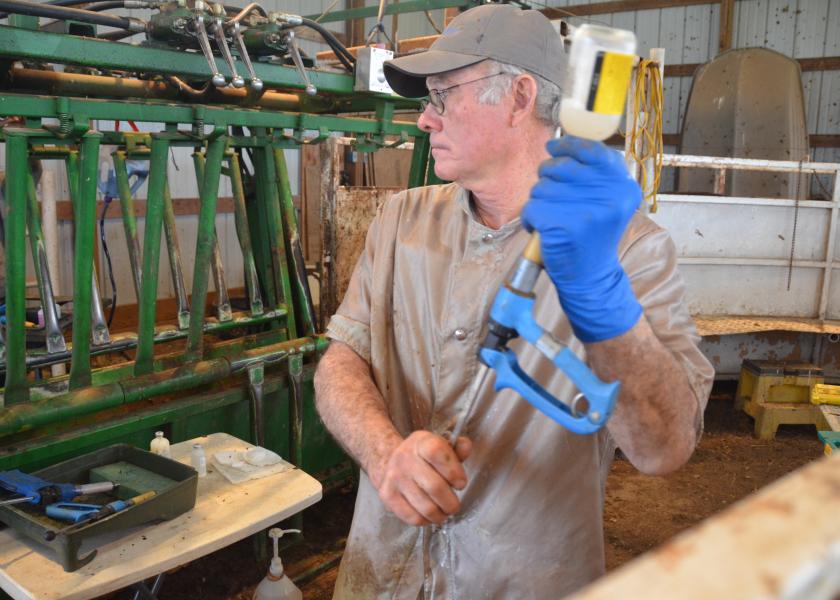Three Ways To Prevent Costly Injection-Site Lesions

This story was developed by Boehringer Ingelheim.
Losses due to injection-site lesions can range from a few dollars docked on a carcass to the entire carcass being condemned, according to Joe Gillespie, DVM, Boehringer Ingelheim.
“They often affect both herd profitability and animal welfare,” he said
Injection-site lesions are typically made of scar tissue that forms in the muscle or subcutaneous tissue following an injection. The lesions must be trimmed and discarded by processors, and the costs of trimming can be as much as $40 per head. (See the reference at the end of this story.)
While lesions are sometimes unavoidable, there are management practices that veterinarians and cattle producers can abide by to protect animal welfare, maintain meat quality and minimize the impact on their operation’s bottom line.
1) Follow label (including needle) directions carefully. This may seem simple, but anytime that you’re administering an animal health product, reading and closely following the directions will help ensure the product is able to perform its job effectively. Any deviation from the label directions can hinder efficacy and increase the likelihood of an injection-site reaction.
Most cattle health products can be administered subcutaneously, and this is the preferred method of administration to preserve meat quality, versus an intramuscular injection.
“No matter the route of administration, it’s best to use a new needle that’s the proper size indicated on the product label, so that you don’t introduce any bacteria into the injection site,” emphasized Dr. Gillespie.
Needles should be new, the appropriate length and no larger than 16 gauge. Note: Using larger or dull needles can traumatize tissue and produce injection site lesions.
2) Don’t push volume limits. In addition to injecting the product with a clean, properly sized needle, it’s extremely important to administer the correct volume. No more than 10 milliliters (mL) should be injected into any given site. This means that some of the products administered in large volumes will require multiple injection sites, spaced at least 4 inches apart.
“While it may not seem like a big deal to give five or ten more cc’s than indicated, any added volume increases the risk of forming an injection-site reaction, no matter what product you’re using,” advised Dr. Gillespie.
Overdosing an injection site also can be a waste of antibiotic treatment, as it does not make the product more effective or treat an animal’s illness faster.
3) Choose a tissue-friendly treatment. Anytime that producers are administering an antibiotic to an animal, there are two goals to keep in mind:
First, the product needs to reach therapeutic levels in a short time frame to effectively treat the animal and maintain therapeutic levels for as long as possible. All products used to treat disease in cattle have their pros and cons, but producers may be paying extra if they’re choosing a high-dose antibiotic in hopes of treating the disease faster.
“Therapeutic levels in antibiotics that treat common calf diseases aren’t much different between 200-milligram (mg) dosage products and 300 mg,” explained Dr. Gillespie. “Infected calves treated with a 300-mg product are receiving a dosage of 1.5 times higher concentration which in theory should mean that you have a significantly longer time of antibiotic levels available in the tissue. However, these products come with an added cost, and typically only last a little bit longer than the lower-concentration options.”
Second, it’s important to avoid any unnecessary irritation to the animal. Ideally, a calf dealing with respiratory disease, foot rot or pinkeye will be administered a fast-acting antibiotic that causes little to no irritation, so that when they get out of the chute, they can go back to the feed bunk and pick up right where they left off.
“You don’t want products to negatively impact the calf’s attitude post injection,” said Dr. Gillespie. “Administering a low-dose antibiotic will minimize the burning sensation or irritation that often leads to calf depression and long-term tissue damage.” When you’re choosing between broad-use antibiotics, he recommends selecting a product formulated with Select Carrier. This unique carrier works to reduce tissue irritation and cattle discomfort, which in turn minimizes costly injection-site lesions and post-treatment tissue reactions.
Finally, producers are strongly encouraged to work with their local veterinarian to assess their herd’s disease risk levels and current treatment protocols, as well as to ensure that they’re able to treat sick cattle both quickly and cost effectively.
Reference:
Hilton WM. Beef quality assurance injection sites and techniques. Purdue University Cooperative Extension Service. 2005. Available at: https://www.extension.purdue.edu/extmedia/VY/VY-60-W.pdf. Accessed May 23, 2018.







